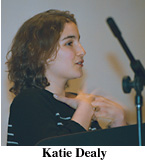Cornell Chronicles
March 23, 2000
Professors, students share their secrets on teaching success
| Stephen H. Weiss presidential fellows Florence Berger, left, professor of hotel administration, and Ali Hadi, professor of statistical science, were among panelists in a faculty forum March 15 in Call Alumni Auditorium. Nicola Kountoupes/University Photography |
By Jacquie Powers
Suggestions for best practices in teaching and learning ranged from providing all faculty members with a Cornell Dining card, adding faculty and cutting class size to changing the seating arrangements in classrooms.
These were among the many specific tips a panel of four Cornell faculty members and two students shared at the University Faculty Forum last week on "Connecting with Students: Some Best Practices in Teaching and Learning at Cornell." The forum, held March 15 in Call Alumni Auditorium of Kennedy Hall, was co-sponsored by J. Robert Cooke, dean of the faculty, and John Ford, the Robert W. and Elizabeth C. Staley Dean of Students.
But a common theme quickly emerged in the panelists' specific recommendations. All agreed that the key to effective teaching is to connect with students as individuals while allowing students to perceive and interact with the professor as an individual.
Panelists included Florence Berger, professor of hotel administration; Ali Hadi, professor of statistical science; Daniel Schwarz, professor of English; Charles Williamson, professor of mechanical and aerospace engineering; senior Katie Dealy, a student trustee; and senior Emanuel Tsourounis, president of the Student Assembly. Faculty members on the panel, which was moderated by Susan Piliero, professor of education and director of the Center for Learning and Teaching, all are Stephen H. Weiss presidential fellows, who are recognized for their excellence in teaching.
Piliero opened the discussion by saying that faculty at big research universities have been accused of neglecting undergraduates and teaching in favor of research. She asked the faculty members on the panel, "who are very good at what they do," she said, to outline their best practices.
Berger said she views teaching as a "shared responsibility. I do not do what they expect me to do -- pour truth into them as they sit passively. It's more about the students engaging in the material."
To achieve that engagement, she brings what she called a bag of gimmicks to her classes to keep them unpredictable. She'll start class with a film clip or with a question or with an exercise. And, she said, she studies students' photos and learns their names before the class begins.

Hadi said he teaches both small and large classes of more than 200 students, and he called on the university to devote more resources to hiring more professors so that class sizes can be cut. But he said that even in his larger classes he tries to learn the names of students. He gives his first prelim about a third of the way into the semester and hands out a paper and has students sign it in the order in which they are seated. During the two hours students are taking the test, he tries to memorize the students' names and link them with their faces.
Hadi said he also asks students to fill out a class evaluation form right after that prelim, and then he responds in class discussion to their comments. That way, he said, they know he cares about their concerns and they benefit from their own comments -- it's not just for the benefit of the next class.
Schwarz said he sees "teaching as learning," and he encourages students to think independently and critically. "My goal is to turn my classroom into a community of inquiry so that students will carry learning beyond the classroom and beyond the life of the course."
Part of his process, he said, is to send out a class letter each week, spelling out for students the plan for the coming week, including the syllabus, any special resources they might access and the questions they will be considering.
Schwarz said it's important to treat each student as an individual and to be accessible. He suggested giving each faculty member a Cornell Dining card, so they can occasionally join students for an informal meal and chat. "That would provide a bridge between class life and life beyond the class," he said.
Williamson said the key to good teaching is both enthusiasm and command of the subject. "Know your stuff, but go into the classroom and have fun. Be approachable, relax. Reveal yourself as a human being. You are not just a conduit of material in books to students."
He also said it's important to get students excited about research. "Share the energy and passion, the successes of your research with them. That's part of it, too."
Dealy said students want a mentor, "someone who can show them the connections between the classroom and outside life," she said. Despite electronic mail and the Internet, she said, personal interaction is still the best way to connect with students, "by offering yourself up as an individual, because we do truly want to see that."
Tsourounis said that in his experience, students are still inclined "to place professors on pedestals and to think of them as transmitters of knowledge, not as mentors and friends." He said his best experiences with faculty members have taken place outside the classroom.
But he seemed to sum up the thinking of the panel members when he said, "The key to good teaching is seeing students as individuals and being an individual yourself."
